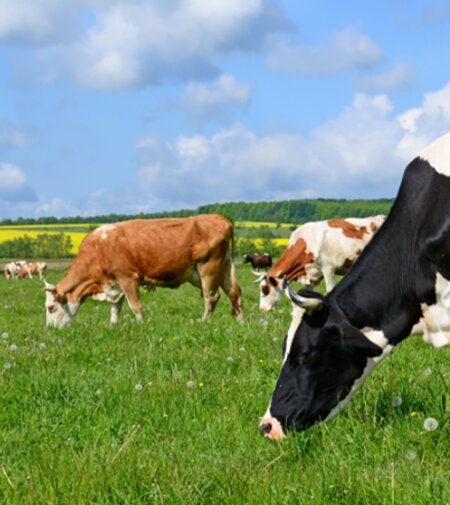
MAP feed material
Monoammonium phosphate is an excellent source of phosphorus for polygastric livestock (cows, sheep, and goats) because their diet requires not only protein, fats, carbohydrates and vitamins, but also minerals such as phosphorus. Phosphorus is known as part of nucleic acids that serve as carriers of genetic information and also participates in the processes of protein biosynthesis and helps immune system reinforcement. In addition, phosphorus in feed additives of inorganic origin can be absorbed by animals no worse than phosphorus of organic origin, which is confirmed by the fact that phosphorus in monoammonium phosphate shows the highest percentage of uptake among feed phosphates (over 91%). The use of this feed additive for enriching and balancing the nutrition of livestock as regards phosphorus, which allows reducing the risk of diseases associated with the lack of this element, contributes to the normalisation of metabolism in the body and the effective functioning of the immune and reproductive systems. The introduction of monoammonium phosphate into the diet of animals as a source of phosphorus for livestock can improve the quality of meat, increase daily weight gain as well as milk production.
| Indicators | Rate | |
| Mass fraction of nitrogen (N), % | 12 | |
| Mass fraction of total phosphorus (P), % | 26.6 | |
| Mass fraction of water, % | 0.2 | |
| Mass fraction of water-insoluble matter, %, no more than | 0.1 | |
| Mass fraction of fluorine (F), mg/kg, no more than | 2000 | |
| Mass fraction of arsenic (As), mg/kg, no more than | 10 | |
| Mass fraction of lead (Pb), mg/kg, no more than | 15 | |
| Mass fraction of cadmium (Cd), mg/kg, no more than | 10 | |
| Mass fraction of mercury (Hg), mg/kg, no more than | 0.1 | |
|
Dioxins (sum of polychlorinated dibenzo-p-dioxins (PCDDs) and polychlorinated dibenzofurans (PCDFs), expressed in World Health Organization (WHO) toxicity equivalents, using WHO-TEF (toxic equivalency factors, 2005)):
|
0.75 0.5
|
|
|
Sum of dioxins and dioxin-like PCBs (sum of polychlorinated dibenzo-p-dioxins (PCDDs), polychlorinated dibenzofurans (PCDFs) and polychlorinated biphenyls (PCBs) expressed in World Health Organization (WHO) toxicity equivalents using WHO toxic equivalency factors (WHO-TEF), 2005):
|
1.0 |
|
|
Dioxin-like PCBs (sum of polychlorinated biphenyls (PCBs) expressed in World Health Organization (WHO) toxicity equivalents using WHO toxic equivalency factors, 2005):
|
0.35 |
|
|
Sum of non-dioxin-like PCBs (PCB 28, PCB 52, PCB 101, PCB 138, PCB 153 and PCB 180 (ICES – 6)),
|
10
|
|
|
Accumulated maximum level of radioactivity according to cesium -134 and -137, Bq/kg, no more than:
|
100 80 160 40 |
|
Feed Safety Policy
Preview
GMP+
Preview

